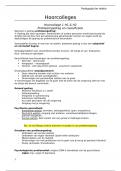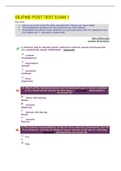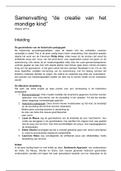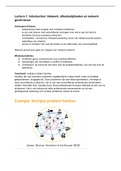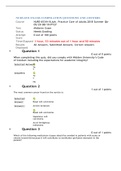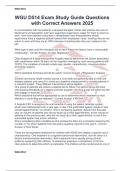PACS, 3rd Edition by Carter Chapters 1-9
Chapter 01: Introduction to Digital Radiography and Picture Archiving and
Communication Systems
Carter: Digital Radiography and PACS, 3rd Edition d. picture archival and
communication systems.
MULTIPLE CHOICE e.
2.
1. Film and intensifying screens are primarily used in
a. computed radiography (CR).
b. digital radiography (DR).
c. conventional radiography.
ANS: C OBJ: Explain latent image formation foarbcirobn.cvoemn/tteisotnal radiography.
3. Intensifying screens
a. absorb light.
b. emit light.
c. absorb scatter.
d. emit positive electronsANS: B OBJ: Explain latent image formation for conventional
radiography.
4. Which modality was the first to use the principle of digital imaging?
a. Computed tomography (CT)
b. Magnetic resonance imaging (MRI)
c. Ultrasonography
d. Cardiac catheterization
ANS: A OBJ: Define the term dig
5. Who was the first to incorporate digital imaging with the CT scanner?
a. Paul Lauterbur
b. Godfrey Hounsfield
c. Sol Nudelman
d. M. Paul Capp
ANS: B OBJ: Define the term digital imaging.
6. Teleradiology, moving images via telephone lines to and farboirmb.croemm/teostte locations,
was first conceptualized by
a. Paul Lauterbur.
b. M. Paul Capp.
c. Albert Jutras.
d. Sol Nudelman.
, ANS: C OBJ: Define digital imaging and communications in medicine.
7. The invention of CT is heralded as
a. the advanced use of three-dimensional computation in medical imaging.
b. one of the greatest milestones in medical imaging.
c. the stepping stone for the development of MRI.
d. the first modality to use PACS.
ANS: B OBJ: Define the term digital imaging.
, 8. Early reconstruction of raw CT data took a few _ to form a recognizable image.
a. minutes
b. hours
c. days
ANS: C OBJ: Define the term digital imaging.
9. The first commercial CT scanners could image the
a. abdomen only.
b. head only.
c. head and abdomen.
d. total body.
ANS: B OBJ: Define the term digital imaging.
10. In which decade was MRI first introduced?
a. 1950s
b. 1960s
c. 1970s
d. 1980s
ANS: D OBJ: Define the term digital imaging.
11. Which two modalities could easily be converted to digital imaging properties?
a. CT and ultrasonography
b. CT and MRI
c. Ultrasonography and nuclear medicine
d. Nuclear medicine and CT
ANS: C OBJ: Define the term digital imaging
12. Early picture archival and communication systems were first developed
a. in Canada.
b. by the U.S. military.
c. by Albert Jutras.
d. by NASA.
ANS: B OBJ: Explain what a PACS is and how it is used.
13. Teleradiography incorporated to produce radiographic images.
a. satellite feeds
b. cable lines
c. T1 cables
d. telephone line
, ANS: D OBJ: Explain what a PACS is and how it is used.
14. One of the early goals related to the development of PACSabwirba.csomto/test
a. reduce costs related to overstaffing.
b. allow radiologists to read stat films from a hospital while at home.
c. provide a means to move battlefield images to an established hospital.
d. eliminate the need for chemical processing.
ANS: C OBJ: Explain what a PACS is and how it is used.
15. CR acquires an image through
a. conventional film/screen processing using a digital scanner.
b. the heating of a thermoluminescent device.
c. an electrically charged cassette.
d. the use of a storage phosphor plate.
ANS: D OBJ: Describe the latent image formation process for PSP image capture.
16. Storage phosphor plates are similar to
a. intensifying screens.
b. xeromammography cassettes.
c. flat panel detectors.
d. cardboard cassettes.
ANS: A OBJ: Describe the latent image formation process for PSP image capture.
17. In a DR system, which of the following are needed to produce a radiographic image?
a. X-ray absorber and a CCD
b. Intensifying screen and a TFT
c. Storage phosphor plate and a CCD
d. Storage phosphor plate and a TFT
ANS: A OBJ: Compare and contrast the latent image formation processes.
18. The two elements needed to convert light signals into an electrical signal while using indirect
capture DR are TFT and
a. photodiodes.
b. photoconductors.
c. phototransistors.
d. photostators.
ANS: A OBJ: Compare and contrast the latent image formation processes.
19. The x-ray absorber typically used in direct capture DR is a
a. photodiode.
b. phototransistor.
c. photoconductor.
d. photoelectron.
ANS: C OBJ: Compare and contrast the latent image formation processes.
20. Technologist efficiency ratings are generally the same wheabnirbc.ocommp/teasrting
conventional radiography with radiography.
a. computed
b. digital
ANS: A OBJ: Compare and contrast the latent image formation processes.

